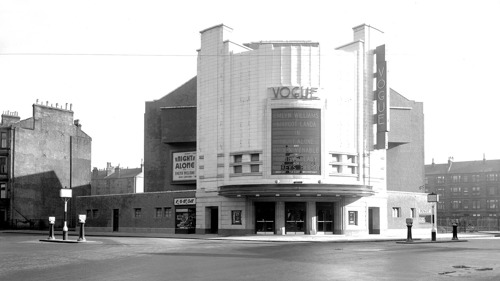Glasgow's Cinemas - Times Past

In partnership with the Glasgow Times, our archivists are exploring Glasgow's fascinating history. This week, Nerys Tunnicliffe writes about Glasgow's cinemas.
Cinema was hugely popular in Glasgow in the 20th century, from the earliest introduction of moving pictures in travelling shows to the later purpose-built cinemas that thrived throughout the city.
Many cinemas offered a touch of luxury and glamour through the movies they showed as well as in their modern auditoriums with warm, comfortable seating and fashionable decor. For the working classes a weekend visit to the cinema was an escape from the trials of city life that could be enjoyed by the whole family.
Sadly many Glasgow cinemas did not survive a growing decline in audiences in the 1970’s and were demolished or their use changed (becoming bingo halls, flats or shops). However, through sources at the City Archives like architectural drawings and photographs, along with entertainment licensing correspondence that details the designs and planning of cinemas, the story of the Glasgow cinemas can still be discovered.
Probably the first instance of moving pictures in Glasgow was during Arthur Hubner’s Real Ice Skating Palace in Sauchiehall Street in May 1896, when a series of seven short films accompanied by an orchestra, was played as a backdrop to the skaters.
More moving pictures were shown at public halls or theatres in the following years until the first permanent cinema, Pringle’s Picture Palace, was opened in 1907. It was converted from the former Queen’s Theatre. Converting existing buildings into cinemas was a common business move, like The La Scala on Sauchiehall Street. Originally a warehouse it opened as a cinema in 1912, one of the largest of its day and an addition of a tearoom was a popular innovation. When it eventually closed in 1984 it was one of the oldest surviving cinemas in Glasgow.
Moving into the 1920’s and 1930’s cinemas sprung up all over the city, as going to the pictures became an established part of life. Cinemas such as the ABC’s flagship cinema The Regal on Sauchiehall that opened in 1929 to replace the Panorama (where Arthur Hubner had shown the first moving picture in the city); Maryhill’s The Roxy built in 1931 popular with soldiers from the nearby barracks; on the southside The White Elephant in Shawlands which included an inside car park; and the Ascot (later Odeon) in Anniesland the last of the larger suburban cinemas built in 1940. Several Glasgow cinemas were stunning Art Deco buildings, their clean lines and modernity adding to their appeal, a contrast to the overcrowded and aged tenement housing many lived in at the time. Examples included the beautiful Vogue Cinema in Govan, designed by James McKissack which opened in 1938 with a capacity of 2500, and the Lyceum Cinema also in Govan, designed by CJ McNair for Caledon Pictures Ltd, that opened in 1938 to replace a previous music hall and cinema.
In the 1930’s Glasgow had over 130 cinemas, more than any other UK city. It’s not surprising then that so many Glaswegians have vivid childhood memories of visiting cinemas, and it’s a privilege to help preserve the history of Glasgow cinemas.
